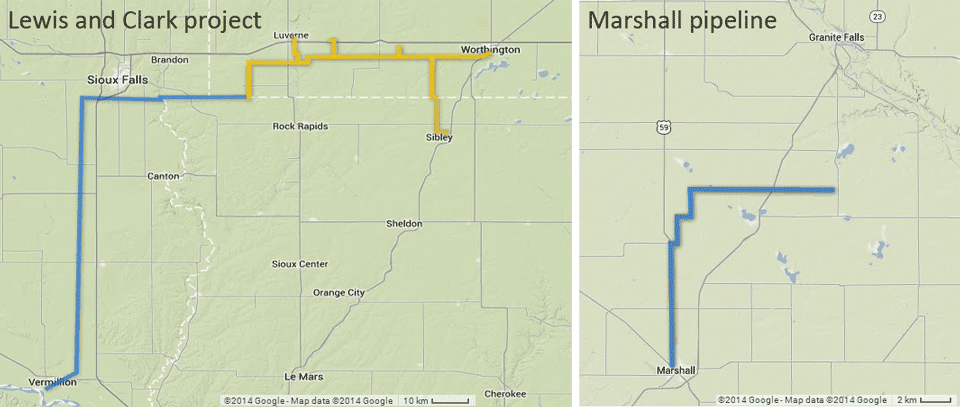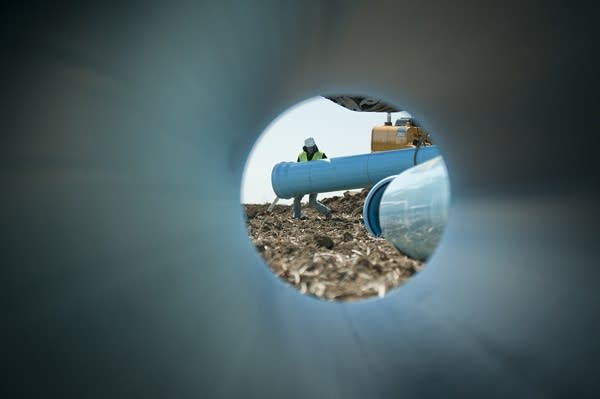In southwest Minnesota, water costs rise, pipes get longer

Go Deeper.
Create an account or log in to save stories.
Like this?
Thanks for liking this story! We have added it to a list of your favorite stories.
Heavy irrigation in farm country and increasing demand in the Twin Cities have raised recent concern among many Minnesotans about the adequacy of their water supplies.
It's an old problem in southwestern Minnesota, but one that is getting more expensive to solve.
• Beneath the Surface, a special Ground Level report
Just this spring, for example, the city of Marshall is laying a $13 million, 27-mile pipe to bring water to its residents and businesses. Not far away, the small town of Mountain Lake, where water levels have dropped, plans this summer to spend a half million dollars for a new well and even then might not get the quality it would like. And the cities of Worthington and Luverne are hoping to convince the Legislature in coming weeks to spend nearly $70 million to let them bring water from South Dakota.
Turn Up Your Support
MPR News helps you turn down the noise and build shared understanding. Turn up your support for this public resource and keep trusted journalism accessible to all.
Some worry that the region's ability to grow economically is at stake. On the other hand, the sense of water awareness many residents and businesses here have developed over the years may be a lesson for other Minnesotans.
"Never enough, never enough supply," is how Leonard Swenson sums the issue up. The retired Dawson area farmer spent years and thousands of dollars searching unsuccessfully for adequate water on his farm.
"Never enough, never enough supply."
In the 1960s and 1970s he drilled at least five wells that failed to yield anything, each for about a thousand dollars. For more than two decades, he spent about $600 a year to have a delivery man truck in water just for the household.
"He had a thousand-gallon tank on the truck, and he'd drive up. And we'd have to have two loads a month," said Swenson. "So it was not a good thing at all."
Swenson eventually was able to hook up to a rural water system that piped a high quality supply to his farm. But even though better distribution systems have solved some problems, water troubles persist in the region today.
Earlier this month, for example, the Mankato-based Center for Rural Policy and Development wondered in a report, "How many cities that would otherwise have growing economies are held back because their water supply or their infrastructure is strained to the point where the state must impose a moratorium on adding one more home bathroom or business restroom?"
In Mountain Lake, supply shrinks, quality declines
Bar owner Diane Radtke was not happy as she scooped up ice cubes in her downtown Mountain Lake business. She pointed to a cloudy layer in each cube that she said came from the extra minerals in the city water supply.
"We need help," said Radtke.

Over the past decade the town's wells have gradually pumped less and less water. Mountain Lake officials aren't sure exactly why, but they believe it's a combination of demand, drought and the general lack of groundwater in this part of the state. At this point, the city of about 2,100 residents doesn't have enough water to run its filtration system efficiently, so minerals remain in the supply, hurting the water's appearance and taste.
"The good news is, we found water. The bad news is it's not going to be done for free."
Standing on the north side of town, Mountain Lake water superintendent Kevin Krahn recalled a years-long effort to find water.
"We did one test well there," he said, pointing. "We went down below in the park and did three test wells there and just never came up with any formation worth actually drilling a well."
Last year, the city finally found a promising site and plans to drill a new well later this year. The city's cost for the well and the connecting pipeline will be about $500,000.
But even if the new well eventually provides sufficient supply, it probably won't be in time for the heavy demand of summertime. Unless the weather turns wet, Mountain Lake residents are probably heading for restrictions on water use.
"Hopefully we get plenty of rain and don't have to worry about it," said Krahn.

Geology determines all
But even rain is in short supply here. Annual precipitation is as much as 10 inches less than in eastern Minnesota. That means there's less high quality water to recharge the region's few aquifers.
"We're trying to look at being more resilient, more sustainable."
"It all comes back really to the history, the geologic history, of Minnesota," said Jim Stark, director of the U.S. Geological Survey's Minnesota Water Science Center.
Glaciers left the southwest corner of the state with little underground structure favorable to aquifers. Things like sandy soil, or porous limestone and sandstone formations. Instead, Stark said, much of southwest Minnesota has clay soils that are great for growing crops but make poor water sources. And underneath the clay typically is hard rock.
"Very old Precambrian and igneous rocks and metamorphic rocks that don't hold or transmit water very readily," Stark said.
Activities taken for granted in other parts of the state can be limited in the southwest by geology. The JBS hog slaughter plant in Worthington is one of the region's biggest employers, but the operation has been forced to drop some plans to expand for lack of water.
It's not uncommon for a town to tell a potential new business that there's not enough water to meet its needs. And when a new business does start up, sometimes it disrupts the local water supply.
That's what happened just outside Granite Falls, a picturesque town of 3,000 on the Minnesota River, about 90 miles north of Mountain Lake. Soon after the Granite Falls Energy ethanol plant began operations in 2005, the water table started dropping, and some residential wells ran dry.

One homeowner wrote state regulators that he was afraid of "running out of water and not being able to live in my home anymore". MPR News contacted the company and some of the affected residents, but all declined interview requests. The company eventually abandoned its wells and began drawing water instead from the river. The ethanol company also paid for new wells or other repairs for several residents of the area.
Marshall pays for a 27-mile straw
That sort of extra spending linked to scarce water supplies happens often in southwest Minnesota. And with spot shortages of groundwater supplies occurring in other parts of Minnesota, those sorts of additional expenses seem likely to spread as well. Almost always, those extra costs are passed on to water customers.
Earlier this month, a backhoe starting tearing into the soil at the construction site of a major water project for the city of Marshall, dozens of lengths of heavy pipe dotting the ground nearby.
At his downtown office, Marshall Municipal Utilities General Manager Brad Roos said the city is spending more than $13 million to build a very long water pipeline. It will stretch a length equal to the distance from downtown Minneapolis to the Wisconsin border.

"Twenty seven miles is the length of the pipe that we need to construct," said Roos. "And that's the closest, adequate water supply that we found during the last 17 years of searching."
The city sells over a billion gallons of water a year to its residential and business customers, and the new pipeline will cost about $1,000 per resident.
"The good news is, we found water, and we're going to be able to harvest it and bring it to the community." said Roos. "The bad news is it's not going to be done for free. There's going to have to be rate increases."
The increases will eventually raise water bills by about one quarter. Marshall residents will pay some of the highest costs in the state, 50 percent more than most St. Paul homeowners, for example, and about triple the rate in Rochester.
One result of the higher rates: Roos said Marshall residents use less water than the national average. Many use low-flow shower heads and other water-saving technology, and the average resident uses roughly 60 gallons a day compared to nearly 100 gallons a day nationally.
Forging water awareness
Roos and other public officials in southwest Minnesota say the publicity generated by water concerns has helped many residents develop a heightened sense of water awareness.
One place you can find it is at Jubilee Fruits and Vegetables in Mountain Lake, a farm on the south side of town where you can hear a chorus of frogs singing from the banks of a retention pond. Owner Judy Harder says conserving water is part of her daily routine. She, her husband, a son and his wife run the place.
One thing they have done is find alternatives to city water for crop irrigation. That's where the retention pond comes in. She says water from the pond will help water their fields this summer.

"We're trying to look at being more resilient, more sustainable in what we're up to," said Harder. "We're just really concerned about water usage. How we leave it for our next generation."
Drawing water from South Dakota
But conservation alone has not been enough to quench the thirst for water in this region. That's why people in the corner of the state are hoping for completion of what is likely the longest water appropriation project in Minnesota history.
The Lewis and Clark water project draws water from the Missouri River aquifer in South Dakota and at this point carries it about 60 miles to the Minnesota border. To complete the project as far as originally envisioned - roughly another 50 miles to Worthington -- would cost $70 million that has yet to be raised.
"We look forward to that," said Mark Johnson, who manages Minnesota's largest rural water system. Lincoln Pipestone Rural Water relies on a few high quality wells and distributes it to farmers and communities in 10 counties. But Johnson said he worried that drought could curtail supplies and the Lewis and Clark project would be more dependable.
"There's been no recorded history when the Missouri River's dried up," said Johnson.
But so far there hasn't been enough money to finish the project. The pipeline ends in a Minnesota farm field just across the Iowa border. Backers hope the Minnesota Legislature will provide the money that Congress cut off, but so far lawmakers haven't acted.
If the legislature says no, Lewis and Clark members may be asked again to fund the Minnesota leg of the project. In a vote last fall though, that approach was overwhelmingly rejected. The project also has the option of going back to Congress for more money. That approach also hasn't worked in recent years.






